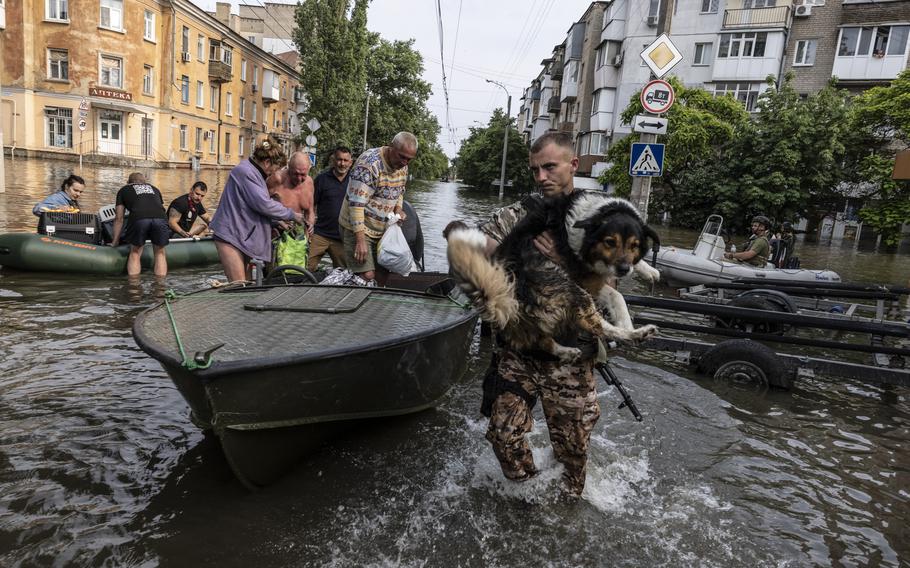
A Ukrainian soldier carries a pet dog through flooded Kherson city on Wednesday as residents evacuate their homes. (Heidi Levine/The Washington Post)
KHERSON, Ukraine — All day Wednesday, rescue crews in paddle boats, motorized rubber rafts and enormous amphibious vehicles ferried passengers across the waist-deep pond that filled what had been an open-air plaza in this riverside city before the dam Kakhovka collapsed.
The families were deposited on a cobblestone ramp, where they put down bundles of salvaged clothing and mementos while police checked their identification. Volunteers waited to escort them to evacuation buses or relatives’ homes. But their expressions were those of loss, bewilderment and uncertainty. Women looked back across the water and wept.
“I have never, ever experienced anything like this,” said Natalya Kabuka, 77, a retired accountant. She stood barefoot on the ramp, keeping watch over a mesh bag containing a neighbor’s cat. She said the house in which she had lived since 1984 filled rapidly with water Tuesday after the dam was breached.
The cause of the catastrophe remained unclear. Ukraine and Russia have blamed each other. But Kabuka knew whom she held responsible.
“I hate the Russians and I wish a curse on them,” she blurted, and then broke into sobs.
In contrast to the chaotic response in flooded areas under Russian occupation, the massive rescue effort in Ukrainian-controlled areas continued smoothly and efficiently until late afternoon. The sun shone brightly, and the only reminder of the war was the occasional soft boom of a Ukrainian rocket being fired toward Russian-occupied territory across the Dnieper River. Much of the Kherson region was occupied for nine months last year but was retaken by Ukrainian troops in October.
At one point, Ukraine’s interior minister, Ihor Klymenko, arrived in a motorcade, took a splashy spin in one of the giant amphibious vehicles called Sherps and told journalists that the government was prepared to provide all needed services to the region. Later, the government reported that a total of 1,752 people had been evacuated from the region.
But Klymenko warned of the danger of ecological damage and contamination from toxic substances in the aftermath of the flooding. He said 1.5 million gallons of oil had spilled into the reservoir surrounding the broken dam, and many factories and gas stations were submerged. Kherson is a major shipbuilding center and port where the Dnieper flows into the Black Sea.
Officials in Kherson declined to comment on how the dam attack and resulting floods might affect the war effort. Several said Ukraine was working closely with the International Criminal Court in The Hague to document the collapse and build a case against Russia for what they say was a terrorist attack on civilians.
But a spokeswoman for the Ukrainian army said the episode would not alter the government’s military plans, nor would flooding near the front lines deter its forces. “Our major obstacle is Russia,” spokeswoman Natalia Humeniuk said. “We are not going to be stopped by a little mud,” she said.
Humeniuk said the flooding had caused Russian forces to retreat from their first lines of defense. She said Russian mines, barricades and trenches on the east side of the Dnieper had been “pushed back” in the past several days.
For the evacuees, though, the immediate concern was how and where they would be sheltered under a relocation program set up quickly by regional authorities. Outside one evacuation bus, a line of people waited anxiously. Serhii Pulayav, 56, a retired welder, said he had no idea where the bus would take him. He was upset to leave his longtime home. “I built it with my own hands, and I don’t have any idea when I can go back,” he said, glumly.
Oxzana Glashevska, 53, was waiting with her sharpei dog and watching a neighbor’s hamster in a cage, both of which she expected to put on the bus. She did not want to leave her apartment of 32 years, she said, but when the water reached two feet, she finally waved to a rescue boat to pick her up. “We couldn’t even let the dog outside any more, so we really had to leave,” she said.
Amid the disruption and anxiety, a busy parallel rescue operation provided an emotional outlet for evacuees and rescue crews alike. As abandoned dogs and cats roamed free, rescue groups spent the day feeding, catching and putting the animals in plastic crates to take to shelters.
People peered into cages, offered snacks and took selfies with rescued pets. There was comic relief when a small dog escaped from his cage and ran around in circles on the crowded ramp, and scattered applause when a frightened and shivering pup, plucked from the water, was gently pushed into a metal crate.
By late afternoon, the human rescue operation had ended for the day, and the last evacuation bus had left. Then, a much louder boom echoed across the once elegant city, now badly damaged by months of fighting. It was a Russian rocket, soon followed by another and another. The streets emptied swiftly, and the reality of an ongoing war — temporarily overshadowed by the busy evacuation operation — suddenly returned.